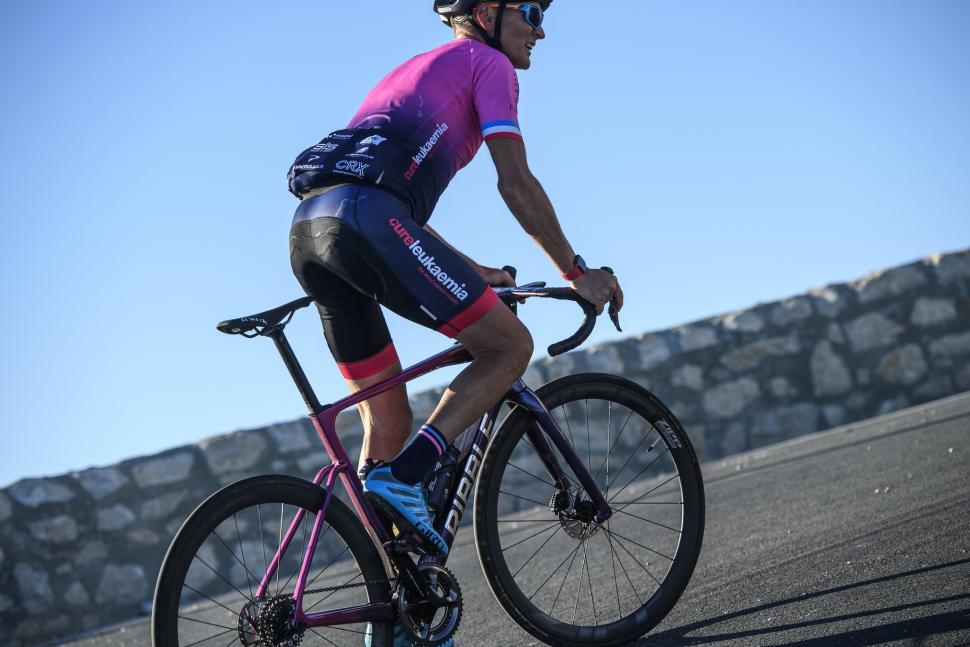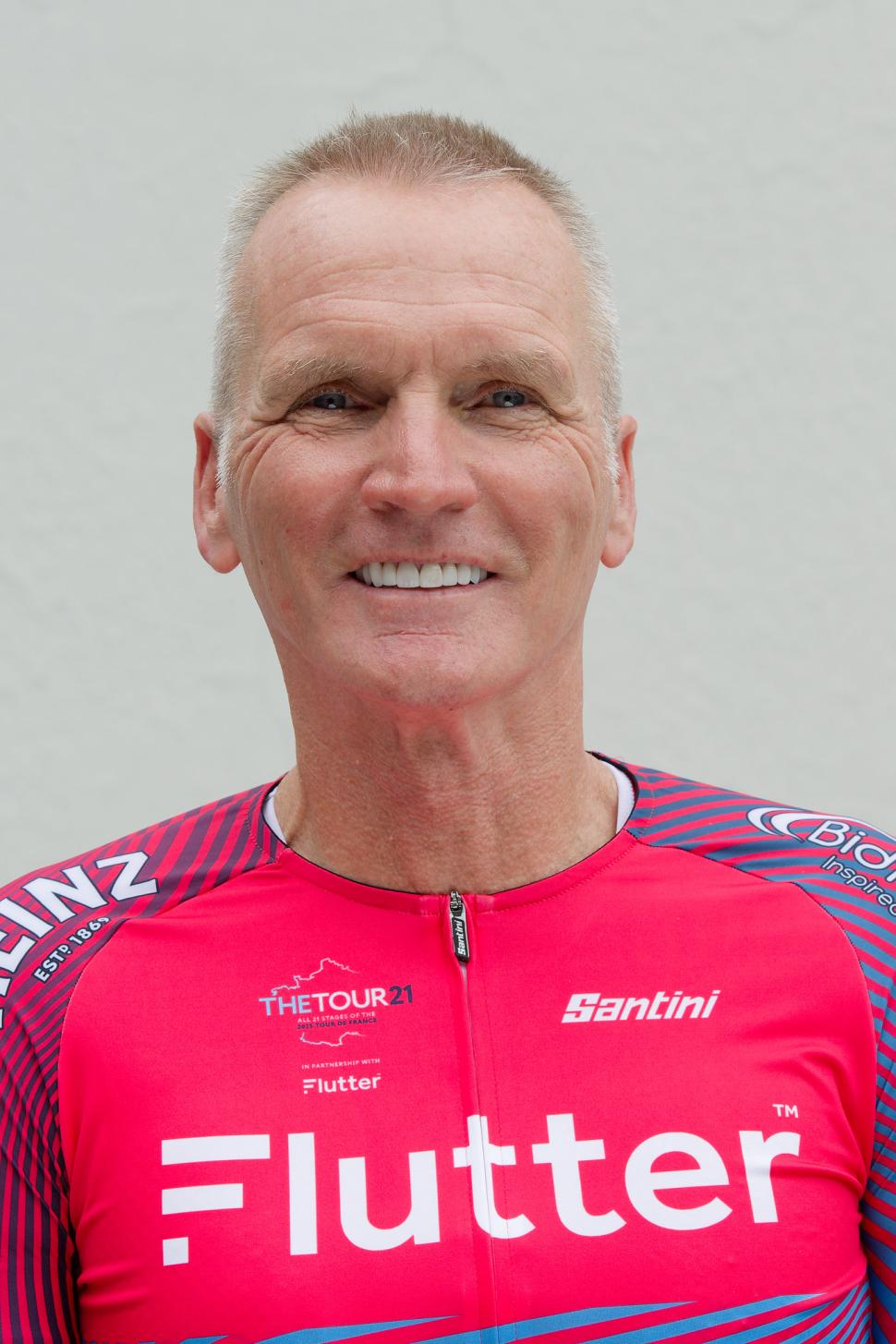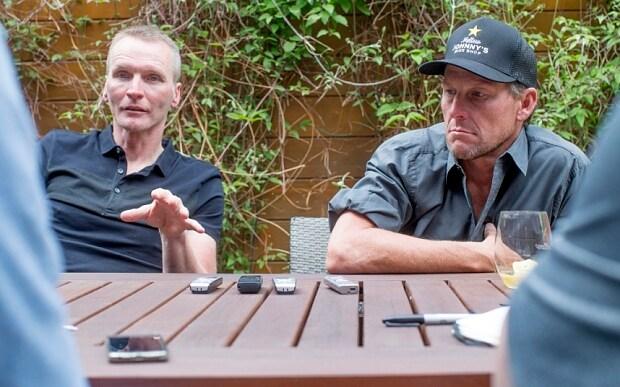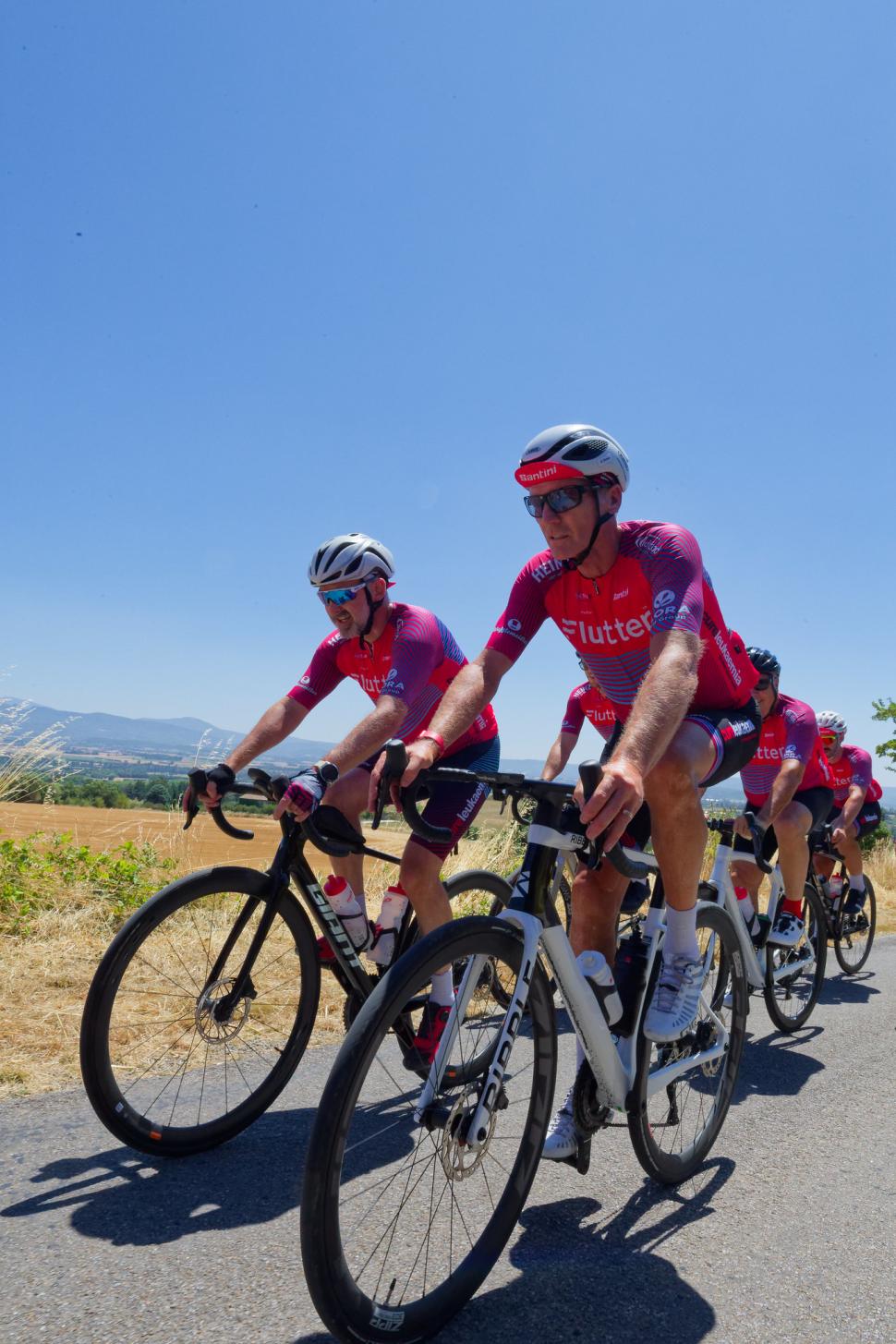July 2005: Geoff Thomas hauls his bike and his body around the next steep, tortuous hairpin bend. He glances up from his bars, expecting, hoping, desperately wishing to see one of his mates, the riders he’d started this cruel, lung-busting mountain with an hour beforehand. But he can’t see anyone. In fact, he can’t see much at all.
It was sunny and warm at the bottom of the Galibier. Proper July, short sleeves, Tour de France weather. It’s not now. The rain which turned to sleet 20 minutes ago has morphed into snow. The clouds envelop as he continues to climb, 2,000m high. The temperature has dropped to three degrees, his bike computer tells him he’s travelling at four miles an hour.
But at least he’s moving. Socks, borrowed from his support crew, are now encasing his hands, a last desperate, almost comical defence against the biting cold. Tears begin to stream down his face. He spots, through the gloom, Neil Ashton, far removed from the warmth of the Sunday Supplement studio, whose throwaway remark ignited this whole sorry endeavour. He’s cowering behind a rock.
‘What the hell am I doing?’ Geoff asks himself, as he crunches his lowest gear around. ‘A few years ago, I was a footballer. And now this?’ And then, suddenly, everything changes.
Ask any cyclist and they’ll tell you the same thing: the summit of a climb – whether it’s an Alpine giant or your local kicker – does strange things to your brain. The pain and anguish are suddenly wiped clear, replaced by the euphoria of the conquest, of survival. And replaced by the descent.
The sun has returned. Geoff’s still got socks on his hands. But the tears are gone, replaced by a beaming smile. Onwards.
“It was brutal. Some days I remember like they were yesterday. The rest is a blur.”
 Geoff Thomas (credit: The Tour 21)
Geoff Thomas (credit: The Tour 21)
Two decades have passed since Geoff Thomas first carved out his own place in cycling history by riding the entire route of the 2005 Tour de France for charity.
Two years before that, in July 2003, he’d been diagnosed with chronic myeloid leukaemia. Thomas, then 38, had just retired from professional football, following a career which earned him nine caps for England and saw him captain Crystal Palace at Wembley in the 1990 FA Cup final against Manchester United, before leading his side to third place in the league the following year.
He was given three months to live.
“That just stopped me in my tracks,” he tells the road.cc Podcast this week.
However, after receiving a stem cell transplant from his sister Kay and undergoing pioneering, life-saving treatment from Professor Charlie Craddock, the co-founder of Cure Leukaemia, Thomas entered remission in January 2005.
And the seeds of an idea were soon planted.
“I was very fortunate that I had a stem cell match,” he says. “I found out not many people have that opportunity.
“So, while I was recovering from arduous radiotherapy, chemotherapy and all that, I was watching other people who didn’t have that opportunity. And I got on so well with Charlie, when I went into some form of recovery – I wasn’t in complete remission at the time – I said, what can I do to help? And he just said, go out there and raise some money.”
Inspired by Lance Armstrong’s autobiography, ‘It’s Not About The Bike’, and a flippant remark by his friend, football journalist Neil Ashton, Geoff pitched the idea of riding the entire 2005 Tour, a day or two before the pros. It was an idea mad, grand, and bold enough that it would surely attract some attention. And money.
Not that Geoff was overly prepared for what lay ahead, however.
 Geoff Thomas (credit: The Tour 21)
Geoff Thomas (credit: The Tour 21)
“I didn’t even have a bike at the time,” he admits. “Ian Botham, in the world of blood cancer, had done so much doing walks and various different challenges.
“And my knees from the world of football were a little bit wrecked after three cruciate operations. So the bike seemed a really good option. I didn’t really know what three weeks of being on the bike would take, to get fit enough for that.
“I got a bike after about three weeks from Bianchi, and I went out on it. And I honestly did six miles and I felt absolutely wiped out. And that was mid-February. But then I said to Neil, yes, come on, let’s commit to it.
“I ended up doing my first 100-mile ride around the Peak District a week before the Tour started.”
As he prepared for his first crack at the Tour, all 21 stages and 3,593km of it, Thomas flitted around the cycling community, picking up all the guidance he could. One piece of advice, from Eurosport’s legendary straw hat-sporting commentator David Duffield, was simple: Respect the Tour.
“He said, you’ll probably walk. And as soon as he said that, I just said, no, I’m not going to put my foot down. That’s one thing I’m not going to do. I might be slow, but I’m not going to put my foot down.
“But I didn’t realise how much pain it was going to be. And it was slow.” Especially on the Galibier, the ceiling of that year’s Tour.
“The Galibier will be in my mind until my dying day. I just thought, what the hell am I doing? But reaching the top – I just pulled on everything I had to just get to the top.
“And the elation of that experience, of doing that and achieving that. It surpassed anything I did on the football pitch, because it actually felt like I got through everything I’ve just been through the last two years.
“And it felt like a moment where I could say, right, I’ve got my life back. Let’s make the most of it.”
.jpg) Geoff Thomas (credit: Leukaemia and Lymphoma Research)
Geoff Thomas (credit: Leukaemia and Lymphoma Research)
That 2005 Tour raised over £250,000 for Cure Leukaemia, and Thomas was awarded the BBC Sports Personality of the Year Helen Rollason Award for 2005. The wheels were set in motion for the next 20 years.
“That was the start of it,” he says.
Since that brutal first ride in 2005, Geoff’s Tour 21 has blossomed into the biggest amateur recreation of cycling’s biggest race, with cyclists following in the former Palace captain’s wheel tracks and raising millions for Cure Leukaemia’s pioneering clinical trials programme every year. A Tour Femmes equivalent, ‘The Route’, is also up and running, and in 2020 Cure Leukaemia was named as the Tour’s first official charity partner in the UK.
“20 years on, we’ve done it a number of times now and things are thankfully improving,” he says, reflecting on the differences between his 2005 and 2025 Tours.
“Rather than having a map on the bonnet of the car, trying to find the route we’re doing that day, we’ve now got proper support vehicles, we’ve got outriders and all this sort of thing now. So yeah, things have improved on and off the bike.”
As the event he started got bigger and bigger, Geoff kept coming back. In 2017, he completed the daunting challenge of riding all three of cycling’s grand tours, the Giro, Tour, and Vuelta, in one year, Adam Hansen-style, and in 2025, after a few years of knee-related trouble, celebrated the 20th anniversary of his first French summer by completing his seventh Tour.
“It was just life-changing for me,” he says, looking back on that debut ride back in 2005. “I’d been through all this procedure and I got told at first I’d probably only have about three years at the most to live.
“So everything was a bonus. I felt like I was doing everything for the people I’d met in the waiting room and in the clinic who hadn’t made it.”
July 2015: Lance Armstrong bounds onto the bus, smiling. Brandishing a copy of an old newspaper, he turns to the group of exhausted cyclists, a glint in his eye, the remnants of all those years on the after-dinner circuit, all those years charming dignitaries and people with deep pockets still strikingly intact. The Texan waves the paper, then reads from it.
It’s a report from the 1912 Tour de France’s final stage in Paris. Armstrong proceeds to recite the reporter’s florid account of the lines of ecstatic fans waving and cheering as the giants of the road pass them. ‘This is what the Tour means,’ he tells the riders. Is Lance emotional? Is he contemplating what has been taken away from him, now no longer a giant but a convict of that same road? Before Geoff can dwell too long on that thought, Armstrong turns, heads out the coach door, and is gone.
The Col du Galibier, Alpe d’Huez, and Mont Ventoux aren’t the only challenges Geoff has faced in his 20 years riding the Tour route and raising funds.
In 2015, he came in for some fierce criticism after he invited Lance Armstrong to join him and team for a few stages of that year’s Tour fundraising ride. This was just two and a bit years on from Oprah, and just under three years on from USADA’s ‘reasoned decision’ that stripped the Texan of his seven yellow jerseys, banned him for life, and cast him as sport’s biggest pariah.
 Lance Armstrong and Geoff Thomas riding the Tour 21 in 2015 (credit: AP)
Lance Armstrong and Geoff Thomas riding the Tour 21 in 2015 (credit: AP)
Brian Cookson, then UCI president, branded Thomas’s invitation to the exiled Armstrong as “inappropriate and disrespectful” to the Tour, while Team Sky chief Dave Brailsford asserted that the Texan should stay away, lest he prove a distraction to Chris Froome’s latest obliteration of the race.
10 years on, and with the wounds of cycling’s EPO era not quite so fresh anymore, Thomas views the polarising response to Armstrong’s participation in a cancer charity ride as indicative of the sport’s murky grey approach to doping and dopers – but admits the whole affair ended up benefiting his charitable aims more than harming them.
“I knew I knew it was controversial, but I wasn’t doing it for anything else. It was a little thank you really,” he says.
“He was an inspiration to millions of people. Everybody had a yellow wristband in the early 2000s. And I was in a dark place for a couple of days until somebody sent me his book. I just wanted to recognise the part he played in my battle against illness.
“I know being banned was painful for him, because he was such a focused guy, but… I’m a sportsman, and he was a cheat. And he’s been lambasted for that, and he’s had all his recognition of winning anything taken away.
“But I saw how much pain he was being when he got chucked out of his own foundation. People were coming to me and saying, do you think this is a good idea? But I spoke to his former soigneur at US Postal, Emma O’Reilly, because I didn’t want to do anything that would hurt people.
“And Emma was the first one to say, you need to get him involved because he’s been on the phone to me and he’s made his apologies. So I thought if Emma can say that, after what she’s been through, then why not?
 Geoff Thomas and Lance Armstrong (credit: AP)
Geoff Thomas and Lance Armstrong (credit: AP)
“I was always thinking about the charity as well, I didn’t want to damage the charity. So, I sort of separated that a little bit by making sure that everybody knew it was my choice.
“I didn’t want to say anything derogatory to the cycling world. But I got to know many cyclists, professional and former professionals, who have talked about the subject and they were probably more forgiving and more understanding than most fans. So I thought there were double standards going on here.
“I lost a few sponsors because of it, but it raised so much awareness. I think it did us more good than bad in the end.
“We invited him out for a couple of stages and he came on the coach to say goodbye to everyone when he was leaving. When he read that passage about the Tour, he got really emotional and he showed how much torment, how much was taken away from him.
“And for a moment you do feel for him. But then he’s a big enough guy and he’s a tough enough guy to crack on, so…”
July 2025: Flanked, just like in his football days, by a team of tough, resilient, like-minded individuals, Geoff Thomas enters Paris on his bike, 20 years on from his first two-wheeled excursion to the French capital. He may be 60 now, and his knees may be creaking, but the bare facts don’t lie: 21 days, 3,300km, Hautacam, Ventoux, pain. And seven Tours. Done. He says it’ll be his last Tour. But, if there’s one thing the last two decades have taught us, it’s to never count out Geoff Thomas. A few weeks later, he’s back on his bike.
“I just feel privileged to be a part of the way it’s grown,” Thomas says, reflecting on the growth of the Tour 21 during the last 20 years.
“There are people I’ve met and become really, really good friends, and people who have taken on the challenge and become great supporters of the cause, who have not been touched by the illness, but really understand why we’re doing it and where the money’s going is so important.”
 Geoff Thomas (credit: The Tour 21)
Geoff Thomas (credit: The Tour 21)
And, after 20 years riding his bike around France, is it fair to say Geoff Thomas, the most impressive bike riding footballer on the planet not called Remco Evenepoel, is now officially a cyclist?
“Normally after I finish a Tour, I put the bike in the garage and forget about cycling altogether, to mentally and physically try to recover properly.
“But then as I get older, I realise that’s a little bit silly really. I’ve been getting out a few times a week, not too much, you know, but I’m trying to get around 100 miles a week, and on Friday I do a nice social rise with a couple of friends.
“I’m enjoying it – a lot more than I have done for a long, time. Because I really feel the benefits physically and mentally of what cycling brings to you. So yes, I’m keeping it up.”
After all, sometimes it really is about the bike.
If you fancy following in Geoff’s wheel tracks and taking on the Tour route just like the pros, details on how to apply for next year’s Tour 21 ride can be found at thetour21.co.uk.
The road.cc Podcast is available on Apple Podcasts, Spotify, and Amazon Music, and if you have an Alexa you can just tell it to play the road.cc Podcast. It’s also embedded further up the page, so you can just press play.

